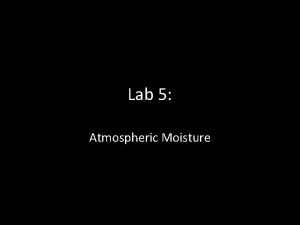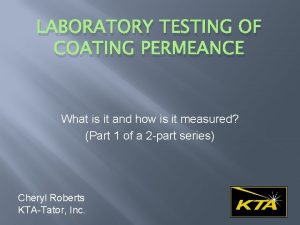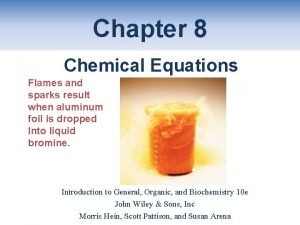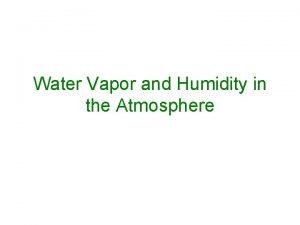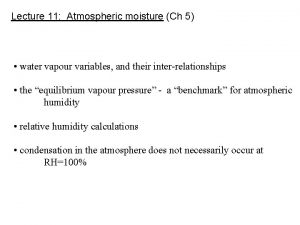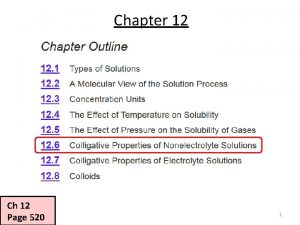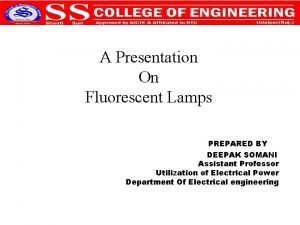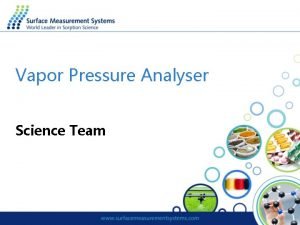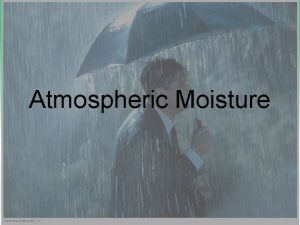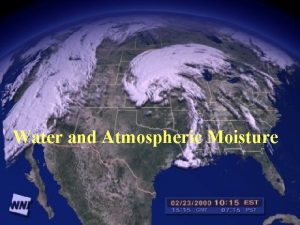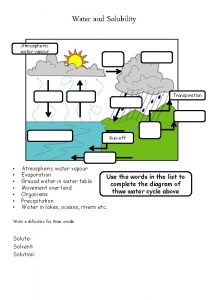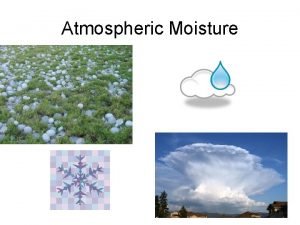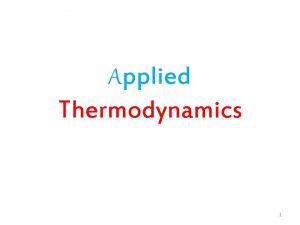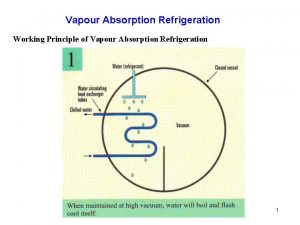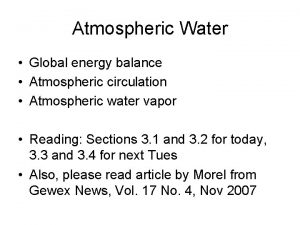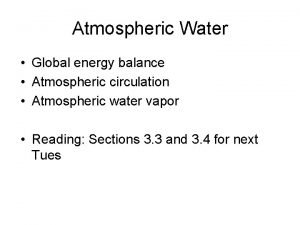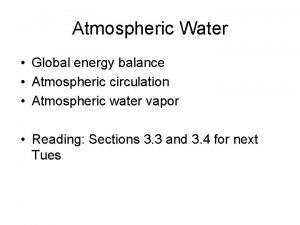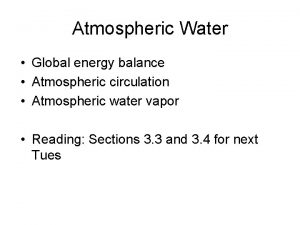Lecture 11 Atmospheric moisture Ch 5 water vapour


![Ideal gas law for water vapor: e , vapor pressure [Pa] v , absolute Ideal gas law for water vapor: e , vapor pressure [Pa] v , absolute](https://slidetodoc.com/presentation_image/d6c0b0cd8e5fbeb39c15ee5f45cb62ec/image-3.jpg)

![courses. eas. ualberta. ca/eas 270/satvp. html es(T) T [o. C] 0 5 10 15 courses. eas. ualberta. ca/eas 270/satvp. html es(T) T [o. C] 0 5 10 15](https://slidetodoc.com/presentation_image/d6c0b0cd8e5fbeb39c15ee5f45cb62ec/image-5.jpg)









- Slides: 14

Lecture 11: Atmospheric moisture (Ch 5) • water vapour variables, and their inter-relationships • the “equilibrium vapour pressure” - a “benchmark” for atmospheric humidity • relative humidity calculations • condensation in the atmosphere does not necessarily occur at RH=100%

Water vapour variables • absolute humidity • vapour pressure (partial pressure of water vapour) • specific humidity • relative humidity • dewpoint temperature Lots of them! How are they inter-related and why do we need so many?
![Ideal gas law for water vapor e vapor pressure Pa v absolute Ideal gas law for water vapor: e , vapor pressure [Pa] v , absolute](https://slidetodoc.com/presentation_image/d6c0b0cd8e5fbeb39c15ee5f45cb62ec/image-3.jpg)
Ideal gas law for water vapor: e , vapor pressure [Pa] v , absolute humidity [kg m-3] Rv = 462 [J kg-1 K-1] , specific gas const. for water vapor T , temperature [K] Form is identical to equation of state for relationship between total pressure, total density, and temperature:

Concept of “equilibrium” (or “saturation”) vapour pressure: • A thought experiment… container and contents held always at fixed temperature T • The unique equilibrium value es depends only on T, so we write e = es(T) • And es(T) becomes our “benchmark” for how much vapour air can hold e=0 e>0 Fig. 5 -2 e = es equilibrium
![courses eas ualberta caeas 270satvp html esT T o C 0 5 10 15 courses. eas. ualberta. ca/eas 270/satvp. html es(T) T [o. C] 0 5 10 15](https://slidetodoc.com/presentation_image/d6c0b0cd8e5fbeb39c15ee5f45cb62ec/image-5.jpg)
courses. eas. ualberta. ca/eas 270/satvp. html es(T) T [o. C] 0 5 10 15 20 es(T) [Pa] 611 873 1228 1705 2338 Fig. 5 -4

True vapour pressure e and dewpoint Td in 1: 1 relationship Fig. 5 -4 e mb • tell me the dewpoint and I can infer the vapour pressure from graph or table Td

True vapour pressure e and dewpoint Td in 1: 1 relationship Notation indicates Td is the inverse of e Fig. 5 -4 e • tell me the vapour pressure and I can infer the dewpoint from graph or table Td

T=15 o. C, Td =10 o. C T =15 o. C, e =1228 Pa Same information T [o. C] es(T) [Pa] 0 611 5 873 10 1228 15 1705 20 2338

Why call the equilibrium** vapour pressure a “benchmark”? . . . • air does not "have" saturation vapour pressure, but has an ACTUAL vapour pressure e • normally e is less than or equal to the "holding capacity" or "benchmark, " es Analogy: your bank account allows an overdraft of $1000. Designate that overdraft limit by the symbol "OL. " Different people, or the same person at different times, have different numerical values for the variable whose symbol is OL. You carry a certain amount of cash ("c", [$]). Perhaps at noon you have c=1. 5 and since you wish to buy a book, you go to an ATM and withdraw $20, so now c=21. 5, until you buy the book. You do not "have" or "carry about" an amount of money OL. OL is, as far as your every day behaviour is concerned, only an idea. The reality in your pocket is the actual amount of cash, c. And OL is only relevant to c in as much as, potentially, you can augment c by drawing on your account, until such time as your account is overdrawn by amount OL. (** I prefer the term “equilibrium” to “saturation”)

Humidity calculations: Suppose the surface analysis for 12 Z (0600 MDT) indicates that (T, Td) = (8, 4) o. C. • What was the relative humidity outside? • If outside air was drawn into your house and mixed well inside without addition of water vapour, and if inside temperature was +21 o. C, what was the relative humidity inside your house? • What was the vapour density (ie. absolute humidity, v) of this inside air? T o. C es(T) [mb] 4 8. 13 8 10. 72 21 24. 86 First, establish the “benchmark” outside, es(T)=es(8)=10. 72 mb Now, establish the actual vapour pressure outside, e= es(4)=8. 13 mb Then, RH outside was RH=100 e / benchmark = 100 8. 13/10. 72 = 76% Inside, the benchmark is es(T)=es(21) = 24. 5 mb. But the actual vapour pressure is just that of the outside air, e=8. 13 mb. So, the RH of the air in the house is RH = 100 8. 13/24. 5 = 33% And, the absolute humidity, from the Gas Law, is: v = e / Rv T = 813 / (462*(273+21)) = 6. 0 x 10 -3 kg m-3 = 6 g m-3

Our common measures of humidity… 1) 2) 3) Vapour pressure deficit (V. P. D. ) e – es(T) T - Td … all relate back to a benchmark whose definition appeals to a plane surface of liquid water. But in the atmosphere, where is this plane surface of free water? . . . Absent!

Condensation may commence at RH < 100% onto tiny “hygroscopic” (water-seeking) particles, e. g. sea-salt (“condensation nuclei”) … or, condensation in a very clean atmosphere might not commence until RH > 100% (“supersaturation”)

Necessary relative humidity of air to cause formation of liquid water droplets in atmos - the curvature effect Assume a pure droplet of radius R which is at same temperature T as air around it. What is the numerical value of the vapour pressure e around the droplet necessary to ensure equilibrium? Is it equal to es(T)? No. Equilibrium can only occur if e > es(T), a condition called “supersaturation”. The smaller the drop radius, the larger the supersaturation necessary to ensure equilibrium (Fig 5 -12). Explanation? The surface area (4 R 2) to volume (4/3 R 3) ratio of our particle is 3/R and so goes to infinity as radius R becomes small… so very easy for liquid water to escape T, e T Fig. 5 -12 R [ m] “If the atmosphere were devoid of aerosols, condensation would occur only by homogeneous nucleation, in which droplets form by chance collision” - such droplets are initially small, so only possible with a high level of supersaturation (p 136)

Necessary relative humidity of air to cause formation of liquid water droplets in atmos - the solute effect Now assume an impure droplet of sufficiently large radius R that the curvature effect can be neglected. Again, let it be at same temperature T as air around it. What is the numerical value of the vapour pressure e around the droplet necessary to ensure equilibrium? Equilibrium occurs at e < es(T). Solutions require less vapour above the surface to maintain equilibrium. Explanation? The solute molecules substitute for water molecles, so there are fewer water molecules adjacent to the surface and able to escape. “under most circumstances” (p 136) the solute effect and curvature effect approxmately cancel, and condensation normally occurs at RH slightly below 100% T, e T
 Lab 5 atmospheric moisture
Lab 5 atmospheric moisture Atmospheric physics lecture notes
Atmospheric physics lecture notes An introduction to atmospheric physics
An introduction to atmospheric physics Water and water and water water
Water and water and water water Water vapour transmission astm1653
Water vapour transmission astm1653 Practice writing chemical equations
Practice writing chemical equations Phosphorus equation
Phosphorus equation Water vapour formula
Water vapour formula How to find vapor pressure of water
How to find vapor pressure of water 01:640:244 lecture notes - lecture 15: plat, idah, farad
01:640:244 lecture notes - lecture 15: plat, idah, farad Partial vapour pressure
Partial vapour pressure Mole concept
Mole concept Freezing point chapter 12
Freezing point chapter 12 Mercury vapour lamp
Mercury vapour lamp Vapour pressure analyser
Vapour pressure analyser
